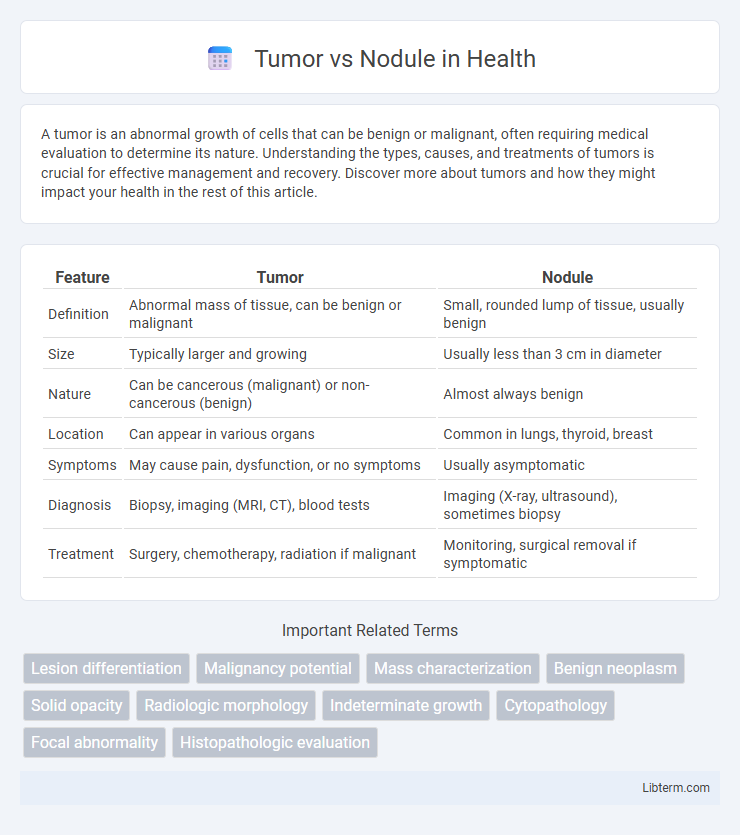A tumor is an abnormal growth of cells that can be benign or malignant, often requiring medical evaluation to determine its nature. Understanding the types, causes, and treatments of tumors is crucial for effective management and recovery. Discover more about tumors and how they might impact your health in the rest of this article.
Table of Comparison
| Feature | Tumor | Nodule |
|---|---|---|
| Definition | Abnormal mass of tissue, can be benign or malignant | Small, rounded lump of tissue, usually benign |
| Size | Typically larger and growing | Usually less than 3 cm in diameter |
| Nature | Can be cancerous (malignant) or non-cancerous (benign) | Almost always benign |
| Location | Can appear in various organs | Common in lungs, thyroid, breast |
| Symptoms | May cause pain, dysfunction, or no symptoms | Usually asymptomatic |
| Diagnosis | Biopsy, imaging (MRI, CT), blood tests | Imaging (X-ray, ultrasound), sometimes biopsy |
| Treatment | Surgery, chemotherapy, radiation if malignant | Monitoring, surgical removal if symptomatic |
Understanding Tumors and Nodules: Key Differences
Tumors are abnormal masses of tissue that can be benign or malignant, often associated with uncontrolled cell growth, whereas nodules are small, rounded lumps that may occur in various tissues and can be either benign or malignant but are typically smaller and less invasive. Tumors vary in size and potential to spread, while nodules are usually more localized and often found in organs such as the thyroid, lungs, or lymph nodes. Understanding the characteristics, growth patterns, and potential malignancy of tumors versus nodules is crucial for accurate diagnosis and treatment planning.
What is a Tumor? Definition and Characteristics
A tumor is an abnormal mass of tissue resulting from uncontrolled cell growth, which can be benign or malignant. Characteristics of tumors include irregular shape, rapid growth, and the potential to invade surrounding tissues or metastasize in malignant cases. Unlike nodules, tumors often disrupt normal tissue function and require medical evaluation to determine their nature and treatment options.
What is a Nodule? Definition and Features
A nodule is a small, rounded mass of tissue, typically less than 3 centimeters in diameter, that can develop in various organs such as the lungs, thyroid, or skin. Unlike tumors, nodules are often benign and may consist of inflammation, scar tissue, or localized cellular growth without malignant potential. Key features of a nodule include its well-defined borders, uniform structure, and absence of invasive behavior on imaging studies or biopsy.
Benign vs Malignant: Tumors and Nodules Explained
Tumors and nodules are abnormal tissue growths, with tumors classified as benign or malignant based on their potential to invade and spread, while nodules are generally smaller, often benign lesions found in organs such as the thyroid or lungs. Benign tumors and nodules typically grow slowly, remain localized, and do not metastasize, whereas malignant tumors exhibit aggressive behavior, rapid growth, and the ability to metastasize to distant tissues. Accurate diagnosis through imaging and biopsy is essential for distinguishing between benign and malignant forms, guiding appropriate treatment strategies and prognostic outcomes.
Common Locations: Where Tumors and Nodules Occur
Tumors commonly occur in organs such as the lungs, liver, breast, and brain, with lung tumors frequently found in the upper lobes and breast tumors developing in the ducts or lobules. Nodules are frequently detected in the thyroid gland, lungs, and lymph nodes, often presenting as small, localized masses. Both tumors and nodules require imaging and biopsy to differentiate their nature, as locations like the lungs and thyroid are prone to both benign nodules and malignant tumors.
Causes and Risk Factors for Tumors vs Nodules
Tumors often develop due to genetic mutations, environmental exposures such as radiation or carcinogens, and lifestyle factors like smoking or diet, increasing the risk of abnormal cell growth and malignancy. Nodules, typically benign, arise from localized tissue inflammation, infections, or cyst formation, with risk factors including chronic irritation, autoimmune conditions, and hormonal imbalances. Differentiating between tumors and nodules is crucial, as tumors have a higher potential for aggressive behavior influenced by inherited predispositions and external carcinogenic influences.
Symptoms and Clinical Presentation Differences
Tumors often present with progressive symptoms such as unexplained weight loss, persistent pain, and noticeable mass effect depending on location, whereas nodules typically cause mild or no symptoms and are frequently discovered incidentally during imaging. Tumors may result in systemic signs including fatigue and fever if malignant, while benign nodules usually remain asymptomatic and localized. Clinical presentation of tumors often includes rapid growth and possible invasion of adjacent tissues, contrasting with nodules that generally exhibit slow growth and well-defined borders.
Diagnostic Approaches: Tumor vs Nodule
Diagnostic approaches for tumors involve advanced imaging techniques such as magnetic resonance imaging (MRI) and positron emission tomography (PET) scans to evaluate malignancy and metastasis potential, often supplemented by biopsy for histopathological confirmation. Nodules are primarily assessed through ultrasound and computed tomography (CT) scans, with fine-needle aspiration (FNA) commonly used to distinguish benign from malignant lesions based on cellular analysis. Molecular testing and biomarker evaluation further refine the diagnostic process, enhancing differentiation between tumors and nodules in clinical practice.
Treatment Options for Tumors and Nodules
Treatment options for tumors often include surgery, radiation therapy, chemotherapy, targeted therapy, and immunotherapy, depending on the tumor's malignancy and location. Nodules, typically benign, are usually monitored through regular imaging or managed with minimally invasive procedures if symptomatic or suspicious. The choice of treatment hinges on accurate diagnosis, biopsy results, and potential malignancy risk.
Prognosis and Outlook: Tumor vs Nodule
Tumors generally indicate abnormal tissue growth that can be malignant or benign, with prognosis varying significantly based on malignancy, size, and location. Nodules are often smaller, benign lumps that usually have a favorable prognosis and minimal impact on health. Malignant tumors require aggressive treatment and have a more guarded outlook, while benign nodules typically involve less risk and better long-term outcomes.
Tumor Infographic

 libterm.com
libterm.com